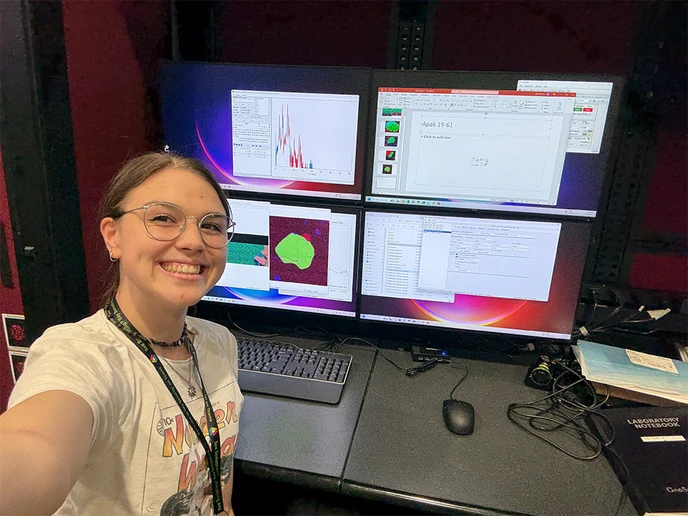

Isabelle “Belle” Price, in front of computers used to analyze x-ray absorption near edge structure (XANES) data.


Isabelle “Belle” Price, in front of computers used to analyze x-ray absorption near edge structure (XANES) data.
Biochemistry major Isabelle “Belle” Price has raised her research acumen to an entirely new level at Argonne National Laboratory.
The Rochester, NY, senior spent fall break at Advanced Photon Source (APS) at the U.S. Department of Energy’s Argonne National Laboratory. APS is touted as the brightest synchrotron X-ray light source in the world.
Ms. Price joined Associate Professor Wentao Cao at APS. Dr. Cao was granted the opportunity to go to APS to run sulfur XANES (X-ray Absorption Near Edge Structure) on apatite in metamorphic rocks that he had collected near the Adirondacks and invited Price to join him for those two days.
This adds additional highlights to her existing portfolios of activities at Fredonia to help her with the pursuit of a future research project in this direction, as experience using this technique and synchrotron facilities in general is uncommon for undergraduates." - Dr. Wentao Cao
They were assigned to sector 13-ID-E, one of many end stations at APS, operated by the University of Chicago’s GSECARS (GeoSoilEnviroCARS). Matt Newville, a beamline scientist and University of Chicago research professor, introduced them to the analytical operation and data analysis.
Price wasn’t a casual observer at APS but was fully engaged in geochemistry research.
“I was able to use the XANES myself and gain hands-on experience with the technique over the course of the 48-hour beam time slot we had, which was super fun,” Price remarked. She proved to be up for the challenge and was able to conduct analysis by herself on the second day of their allotted APS time.
“There are not that many synchrotrons that are accessible to undergraduates; even researchers have to schedule time to use them,” Price noted. All researchers undergo a federal review to receive beamtime.
Cao indicated Price is interested in future research directions using X-ray Absorption Spectroscopy (XAS) techniques. Price’s research there using the synchrotron beamline has given her direct experience in analyzing geological specimens with XAS, Cao said.
“This adds additional highlights to her existing portfolios of activities at Fredonia to help her with the pursuit of a future research project in this direction, as experience using this technique and synchrotron facilities in general is uncommon for undergraduates,” according to Cao.
Price's background in Biochemistry and Chemistry and interest in Geology are important contributors to this research experience, Cao continued.
“In addition, her prior internship in Experimental Petrology has introduced her to the technique and various materials related to the project,” Cao explained. “We are lucky to recruit her to the Geoscience research project at the perfect time, when the beamtime was approved.”
Price’s APS experience follows her summer REU (Research Experience for Undergraduates) at Cornell University and was a logical next step.
“My time at Cornell was spent studying the effects of different redox states of sulfur in peridotite melts, so I already had an interest in studying sulfur. As electrons travel around the synchrotron, they are bent by magnets, which cause them to emit high intensity beams of light, which are then channeled to beam lines which are stations where channels can be analyzed,” Price explained.
“We were bombarding thin metamorphic rock sections with x-rays to see the redox state of sulfur in the mineral apatite to tell different things about the elements in our rocks samples.”
Price, who gained hands-on experience with various instruments at Argonne, brought back home data to analyze on her own computer over the next several months.
The reason why going to APS was “extra cool,” Price noted, was that she heard about XANES from her REU mentors at Cornell who were traveling there over the summer.
Price was responsible for raising money to cover all APS expenses, including travel, in less than one month. She successfully raised the $650 needed from the Raffaele Borriello, MD, and Suzanne T. Casden Chemistry Department Endowment and the Mara Experiential Learning Fund in the Department of Geology and Environmental Sciences.
The APS experience will undoubtedly help Price stand out among graduate school applicants. She plans to enroll in a Ph.D. program in planetary science, geochemistry or geoscience, with Cornell, University of Chicago and Purdue University among her top choices of eight schools under consideration.